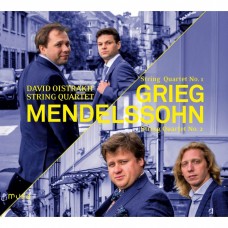|
The first disc of the David Oistrakh String Quartet met with praise from the press. Earning comparison with the Borodin Quartet and the Beethoven Quartet, this young group returns with impassioned performances of Grieg and Mendelssohn.
The Quartet in G minor should be considered the only quartet entirely written by EdvardGrieg, and it is a major work in the repertory. Written in 1878, its composer was then in full possession of his talents and was using an instantly recognisable modern language inspired by traditional national sources. For him, tackling the composition ofa quartet was a huge challenge as his fame had thus far been based on the cultivation of small forms, for the piano, though also songs, and indeed he took one of his lieder, Spillemaend(Minstrel), as the main theme of his quartet. The work, written in a musical language that was innovative for the time, quickly acquired great popularity and was to influence many composers.
Like many of his contemporaries Felix Mendelssohn was deeply marked by Beethoven, and was full of admiration for his quartets. Like Grieg, he took inspiration from one of his own themes to construct his Quartet No.2, that of his lied Frage(Question). Written just after Beethoven's death, his mourning produced a work of extraordinary maturity and tempestuousness, even if the work ends in serenity. Beneath a homage to Beethoven lies hidden a surge of love, that of a young man moving out of his teenage years, yet already an absolute master of his art and ready to lay claim to his elder's torch.
"No sooner formed, this young quartet alreadyreaches excellence." "It is a joy to see the birth of a new quartet of international class, excellent in every respect." "A group to be followed closely." "A phenomenal decryption… that is never toned down": such is the welcome accorded to the David Oistrakh Quartet, led by the violinist Andrey Baranov, for its first recording. Their powerful, contrasted, physical yet always subtly emotional performance suits these two new works in the repertory to a wonderful degree.
Edvard GRIEG (1843-1907) – Quatuor a cordes n° 1 en sol mineur, Op. 27
1. I. Un poco andante – Allegro molto ed agitato 11'48
2. II. Romanze: Andantino – Allegro agitato 5'49
3. III. Intermezzo: Allegro molto marcato – Più vivo e scherzando 6'24
4. IV. Finale: Lento – Presto al saltarello 7'58
Felix MENDELSSOHN (1809-1847) – Quatuor a cordes n° 2 en la mineur, Op. 13
5. I. Adagio – Allegro vivace 7'24
6. II. Adagio non lento 8'10
7. III. Intermezzo: Allegretto con moto – Allegro di molto 4'33
8. IV. Presto – Adagio non lento 8'22
9. Niccolo PAGANINI (1782-1840) – Caprice pour violon seul n° 20 en rE majeur, Op. 1 (transcription pour quatuor a cordes par Fedor Belugin) |
|



